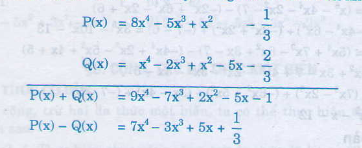Hãy nhập câu hỏi của bạn vào đây, nếu là tài khoản VIP, bạn sẽ được ưu tiên trả lời.

\(f\left(x\right)+h\left(x\right)-g\left(x\right)\)
\(=\left(5x^4+3x^2+x-1\right)+\left(-x^4+3x^3-2x^2-x+2\right)\)
\(-\left(2x^4-x^3+x^2+2x+1\right)\)
\(=\left(5x^4-x^4-2x^4\right)+\left(3x^3+x^3\right)+\left(3x^2-2x^2-x^2\right)\)
\(+\left(x-x-2x\right)+\left(-1+2-1\right)\)
\(=2x^4+4x^3-2x\)

Ta có:
P(x) = 2x4 –x - 2x3 + 1
Q(x) = 5x2 – x3 + 4x
H(x) = -2x4 + x2 + 5.
Sắp xếp các đa thức theo lũy thừa giảm dần rồi xếp các số hạng đồng dạng theo cùng cột dọc ta được:

ta có:
P(x) = 2x4 –x – 2x3 + 1
Q(x) = 5x2 – x3 + 4x
H(x) = -2x4 + x2 + 5.
Sắp xếp các đa thức theo lũy thừa giảm dần rồi xếp các số hạng đồng dạng theo cùng cột dọc ta được:


1. a)
\(h\left(0\right)=1+0+0+....+0=1\)
\(h\left(1\right)=1+\left(1+1+....+1\right)\)
( x thừa số 1)
\(=x+1\)
Với x là số chẵn
\(h\left(-1\right)=1+\left(-1\right)+\left(-1\right)^2+\left(-1\right)^3+...+\left(-1\right)^{x-1}+\left(-1\right)^x=1-1+1-1+...-1+1-1=-1\)
Với x là số lẻ
\(h\left(-1\right)=1-1+1-1+1-....+1-1\) =0
b) Tương tự

a/ \(f\left(-\dfrac{1}{2}\right)=4.\left(-\dfrac{1}{2}\right)^2+3.\left(-\dfrac{1}{2}\right)-2\)
\(=4\cdot\dfrac{1}{4}-\dfrac{3}{2}-2=1-\dfrac{3}{2}-2=-\dfrac{5}{2}\)
b/
\(f\left(x\right)+g\left(x\right)-h\left(x\right)=4x^2+3x-2+x^2+2x+3-5x^2+2x-8\)
\(=\left(4x^2+x^2-5x^2\right)+\left(3x+2x+2x\right)+\left(-2+3-8\right)\)
\(=7x-7\)
Ta có: \(f\left(x\right)+g\left(x\right)-h\left(x\right)=7x-7=0\)
\(\Leftrightarrow7x=7\Rightarrow x=1\)
Vậy để...............
c/ \(g\left(x\right)=x^2+2x+3=\left(x^2+2x+1\right)+2=\left(x+1\right)^2+2\)
Vì \(\left(x+1\right)^2\ge0\forall x\Rightarrow\left(x+1\right)^2+2\ge2\)
hay \(\left(x+1\right)^2+2>0\)
\(\Rightarrow g\left(x\right)\) vô nghiệm (đpcm)

Ta có: \(F\left(x\right)+G\left(x\right)-H\left(x\right)=0\)
\(\Leftrightarrow4x^2+3x-2+3x^2-2x+5-5x^2+2x-3=0\\ \Leftrightarrow2x^2+3x=0\\ \Rightarrow x\left(2x+3\right)=0\\ \Rightarrow x=0;x=\dfrac{-3}{2}\)
Vậy tìm được x thỏa mãn là: \(x=0;x=\dfrac{-3}{2}\)

Bài 1:
a) \(f\left(x\right)=2x\left(x^2-3\right)-4\left(1-2x\right)+x^2\left(x-1\right)+\left(5x+3\right)\)
\(=2x^3-6x-4+8x+x^3-x^2+5x+3\)
\(=x^3-x^2+7x-1\)
\(g\left(x\right)=-3\left(1-x^2\right)-2\left(x^2-2x+1\right)\)
\(=-3+3x^2-2x^2+4x-2\)
\(=x^2+4x-5\)
b) \(h\left(x\right)=f\left(x\right)-g\left(x\right)\)
\(=x^3-x^2+7x-1-x^2-4x+5\)
\(=x^3-2x^2+3x-4\)

Bài này chill ha ? nhưng ko ai lm cx lạ :vvv
a, Ta có : \(f\left(1\right)=5.1-1^3+3.1^2-1=5-1+3-1=6\)
\(g\left(-1\right)=-\left(-1\right)^3+3\left(-1\right)^2+2\left(-1\right)-3=1+3-2-3=-1\)
\(f\left(1\right)-g\left(-1\right)=6-\left(-1\right)=7\)
b, Ta có :
\(h\left(x\right)=f\left(x\right)-g\left(x\right)=\left(5x-x^3+3x^2-1\right)-\left(-x^3+3x^2+2x-3\right)\)
\(=5x-x^3+3x^2-1+x^3-3x^2-2x+3=3x+2\)
c, \(\left|h\left(x\right)-5\right|+2x=2,5\Leftrightarrow\left|3x+2-5\right|+2x=2,5\)
\(\Leftrightarrow\left|3x-3\right|+2x=2,5\Leftrightarrow\left|3x-3\right|=2,5-2x\)
Chia 2 TH nhá vì lười :3 (nhưng ko dám chắc nha men)

a) Thu gọn, sắp xếp các đa thức theo lũy thừa tăng của biến
f(x)=x2+2x3−7x5−9−6x7+x3+x2+x5−4x2+3x7
= -9 - 2x2 + 3x3 - 6x5 - 3x7
g(x)=x5+2x3−5x8−x7+x3+4x2−5x7+x4−4x2−x6−12
= -12 + 3x3 + x4 + x5 - x6 - 6x7 - 5x8
h(x)=x+4x5−5x6−x7+4x3+x2−2x7+x6−4x2−7x7+x
= 2x - 3x2 + 4x3 +4x5 -4x6 - 10x7
b) Tính f(x) + g(x) − h(x) = ( -9 - 2x2 + 3x3 - 6x5 - 3x7 ) + (-12 + 3x3 + x4 + x5 - x6 - 6x7 - 5x8 ) - (2x - 3x2 + 4x3 +4x5 -4x6 - 10x7)
= - 9 - 2x2 + 3x3 - 6x5 - 3x7 -12 + 3x3 + x4 + x5 - x6 - 6x7 - 5x8 - 2x + 3x2 - 4x3 - 4x5 + 4x6 + 10x7
= -21 - 2x + x2 + 2x3 + x4 - 9x5 + 3x6 + x7 - 5x8

Ta có: P(x) = -5x3 - 1313 + 8x4 + x2 và Q(x) = x2 – 5x – 2x3 + x4 - 2323.
Ta sắp xếp hai đa thức theo lũy thừa giảm dần của biến như sau:
 .
.
Ta có: P(x) = -5x3 – 1/3 + 8x4 + x2 và Q(x) = x2 – 5x – 2x3 + x4 – 2/3.
Ta sắp xếp hai đa thức theo lũy thừa giảm dần của biến như sau:

a: \(H\left(x\right)+P\left(x\right)=x^5-2x^2+2\)
=>\(P\left(x\right)=x^5-2x^2+2-H\left(x\right)\)
\(=x^5-2x^2+2-x^4+5x^3-x^2-5x+\dfrac{1}{3}\)
\(=x^5-x^4+5x^3-3x^2-5x+\dfrac{7}{3}\)
b: H(x)-Q(x)=-23=-8
=>Q(x)=H(x)+8
\(=x^4-5x^3+x^2+5x-\dfrac{1}{3}+8\)
\(=x^4-5x^3+x^2+5x+\dfrac{23}{3}\)